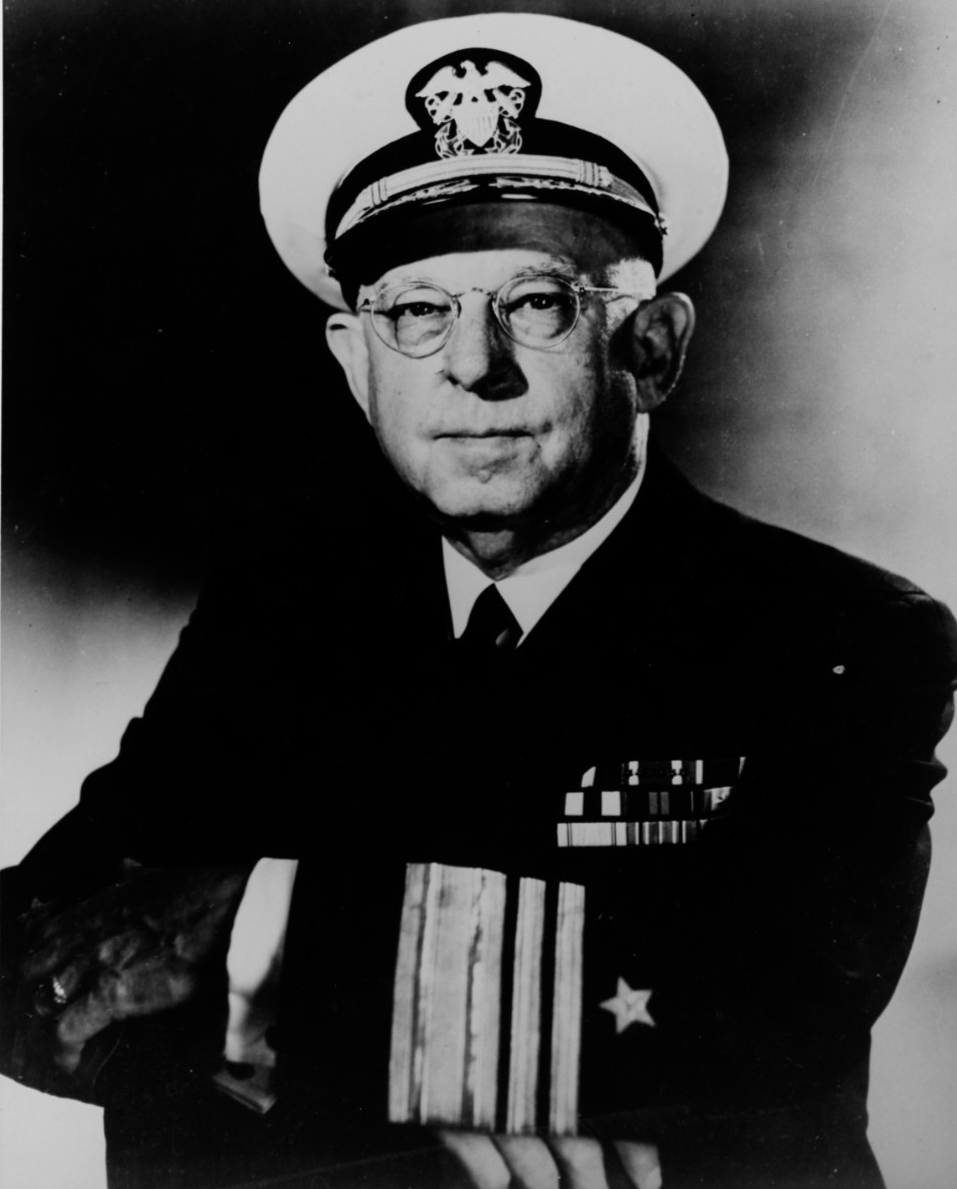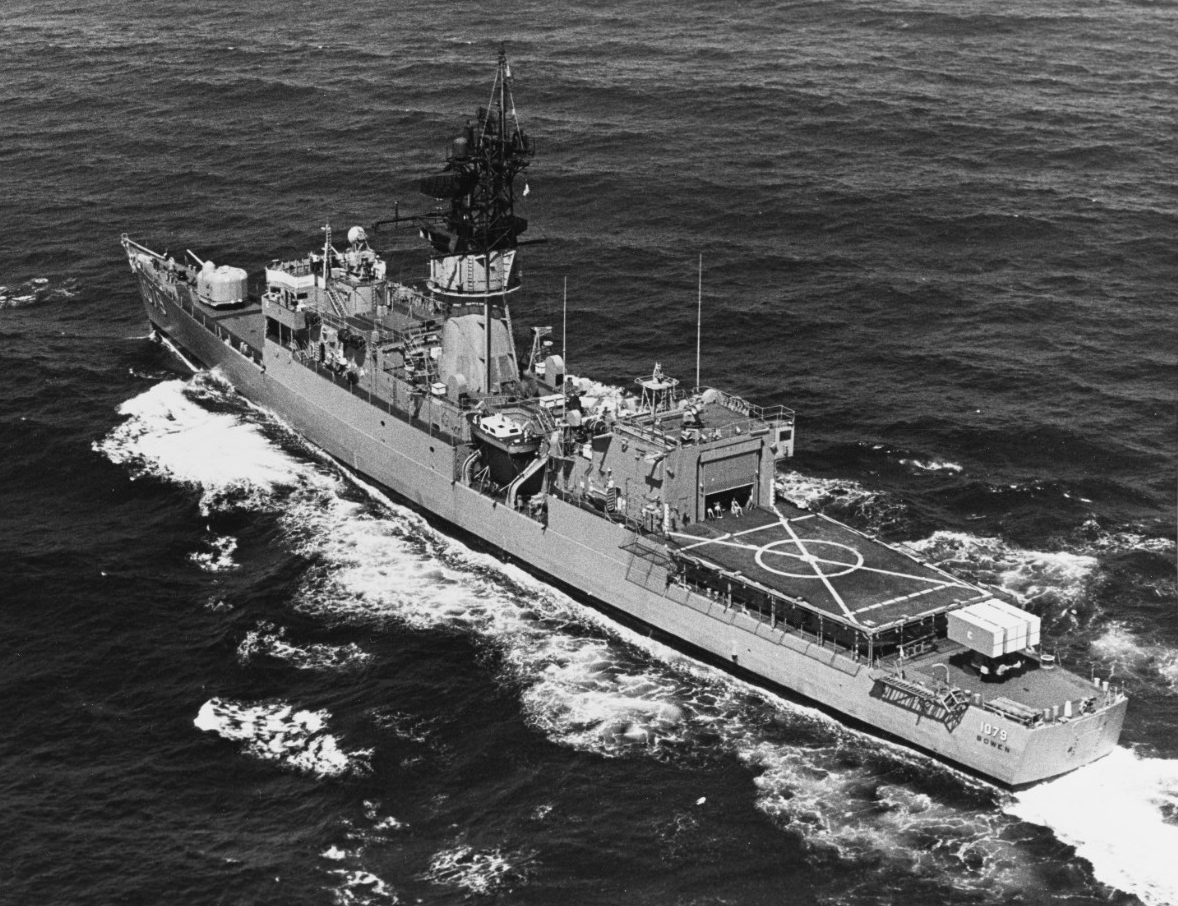USS Bowen (DE/FF-1079)
1971–1995
Named for Vice Admiral Harold G. Bowen Sr. (1883-1965), an accomplished U.S. naval officer who served as Assistant Chief of the Bureau of Engineering (1931-1935) and later as Chief of the Bureau of Engineering (1935-1939). During his time in those positions, he advanced shipboard electrical and mechanical systems, contributing greatly to the modernization of the Navy through innovations such as standardized steam pressures, enclosed boilers, high-speed turbines, double reduction gears, closed feed systems, alternating current, auxiliary diesel generators, flameproof cables, electric drive, and multi-cylinder diesels in submarines. In the twilight of his career, Bowen served as Special Assistant to James V. Forrestal, who was the Undersecretary of the Navy from 1942-1944 and Secretary of the Navy from 1944-1947. On 19 May 1945, Bowen was appointed the first Chief of the Office of Research and Inventions (ORI), where he pioneered efforts to advance the Navy’s use of nuclear energy.
(DE/FF-1079: displacement 4,100 tons; length 438'; beam 46'9''; draft 24'9''; speed 27 knots; complement 244; armament 1 5-inch/54 caliber gun mount, Anti-Submarine Rocket (ASROC) system, Light Airborne Multi-Purpose System (LAMPS) I; class Knox)
Bowen was laid down on 11 July 1969, at Avondale Shipyards, Westwego, La.; launched on 2 May 1971 and co-sponsored by Mrs. Constance K. (Baker) Bowen and Mrs. Constance R. (Bowen) Camp, Vice Adm. Harold G. Bowen Sr.’s daughter-in-law and granddaughter; commissioned on 22 May 1971, at the Boston Naval Shipyard, Boston, Ma., Cmdr. Donald L. Howard in command.
Following her commissioning, Bowen was homeported at Newport, R.I., and assigned to Destroyer Squadron Twenty. A new class of ocean escort destroyer, Bowen was specifically designed to locate and destroy submarines. Her agile frame also made her well suited for screening amphibious support forces, replenishment forces, and task forces, as well as patrolling coastal waters, conducting naval gunfire support, and escorting convoys.
In the course of her 24-year career as a commissioned U.S. warship, Bowen engaged in multiple deployments around the world, and participated in numerous training and operational missions.
While conducting her first of several deployments to the Mediterranean Sea, Turkish military forces invaded the Greek island of Cyprus on 20 July 1974, escalating the humanitarian crisis in the country. As part of a United Nations response to the incident, Bowen aided in the evacuation of endangered civilians.
On 30 June 1975, Bowen was reclassified as a frigate.
In 1977, Bowen deployed to the Indian Ocean, and the following year deployed to the waters of South America.
Perhaps one of Bowen’s most historically significant years was 1983. While deployed in the Persian Gulf early in the year, the frigate operated adjacent to the chaos and devastation of the Iran-Iraq War (1980-1988). For successfully completing her mission amid such especially hazardous conditions, her crew was awarded the Meritorious Unit Commendation.
After departing the Persian Gulf in September of that year, Bowen forward deployed to the coast of Lebanon, a nation embroiled in civil war. On 16 September 1983, U.S. Marines attached to the United Nations Multi-National Peacekeeping force at Beirut International Airport, Lebanon, came under direct fire from Druze artillery. Steaming just off the coast, Bowen’s 5-inch guns began shelling hostile artillery batteries, rocket sites, and command and control centers. The frigate’s actions made headlines, as she became the first U.S. Navy ship to conduct naval gunfire support in the Mediterranean Sea since the end of World War II. Other U.S. warships also joined Bowen in the bombardment and helped to ensure the safety of U.S. ground forces. For her service in these operations, Bowen received the Navy Expeditionary Medal.
During the winter of 1984, Bowen conducted a demanding cruise of the North Atlantic and Arctic, during which she participated in two major North Atlantic Treaty Organization (NATO) exercises.
In 1985, Bowen made another major deployment to the Mediterranean Sea. During the course of her cruise there, she acted as the U.S. representative for NATO’s 30th Naval On-Call Forces Mediterranean activation.
In the course of her 1987 deployment to the Mediterranean, Bowen was singled out as the “most proficient Anti-Submarine Warfare combatant” in her Battle Group.
While conducting operations in the eastern Pacific and Caribbean Sea during the months of April, May, and June 1991, Bowen was involved in what was then the largest drug seizure in the history of joint U.S. Navy and U.S. Coast Guard operations. Steaming as part of Task Group 4.1 more than 100 miles south of Panama, Bowen, accompanied by the guided missile frigate Samuel Eliot Morison (FFG-13), intercepted a 65-foot ship flying a Honduran flag and bearing the name Endeavor 1. A Coast Guard Law Enforcement Detachment team assigned to the frigates conducted a search of the suspect vessel and seized 2.5 tons of cocaine.
In 1992, Bowen was re-designated as a training ship, and started training naval reservists. It was during that time that the ship also converted to a mixed sex crew.
Bowen was decommissioned on 30 June 1994 and subsequently leased to the Turkish Navy, where she was re-named TCG Akdeniz (F 257).
Bowen was struck from the U.S. Naval Vessel Register on 11 January 1995.
On 2 February 2002, Akdeniz was officially transferred to Turkey under the terms of the Foreign Assistance Act.
Commanding Officers |
Date Assumed Command |
Cmdr. Donald L. Howard |
22 May 1971 |
Cmdr. Harry K. Fiske |
10 September 1972 |
Cmdr. John P. Burke |
17 January 1974 |
Cmdr. Clarence T. Vaught |
3 January 1976 |
Cmdr. William F. Story |
6 December 1977 |
Cmdr. William A. Estell Jr. |
25 January 1980 |
Cmdr. Arthur P. Drennan II |
7 January 1983 |
Cmdr. Robert D. Moser |
15 June 1985 |
Cmdr. Richard A. Robbins |
29 May 1987 |
Cmdr. Gregory G. Heath |
19 May 1989 |
Cmdr. James T. Fry |
27 Jul 1991 |
Cmdr. Anthony J. Abbruzzi, Jr. |
29 May 1993 |
Jeremiah D. Foster
25 October 2019




